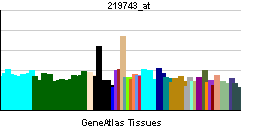HEY2
| Hairy/enhancer-of-split related with YRPW motif 2 | |||||||||||
|---|---|---|---|---|---|---|---|---|---|---|---|
| Identifiers | |||||||||||
| Symbols | HEY2 ; GRL; CHF1; HERP1; HESR2; HRT2; MGC10720 | ||||||||||
| External IDs | Template:OMIM5 Template:MGI HomoloGene: 22705 | ||||||||||
| |||||||||||
| RNA expression pattern | |||||||||||
 | |||||||||||
| More reference expression data | |||||||||||
| Orthologs | |||||||||||
| Template:GNF Ortholog box | |||||||||||
| Species | Human | Mouse | |||||||||
| Entrez | n/a | n/a | |||||||||
| Ensembl | n/a | n/a | |||||||||
| UniProt | n/a | n/a | |||||||||
| RefSeq (mRNA) | n/a | n/a | |||||||||
| RefSeq (protein) | n/a | n/a | |||||||||
| Location (UCSC) | n/a | n/a | |||||||||
| PubMed search | n/a | n/a | |||||||||
Hairy/enhancer-of-split related with YRPW motif 2, also known as HEY2, is a human gene.[1]
This gene encodes a member of the hairy and enhancer of split-related (HESR) family of basic helix-loop-helix (bHLH)-type transcription factors. The encoded protein forms homo- or hetero-dimers that localize to the nucleus and interact with a histone deacetylase complex to repress transcription. Expression of this gene is induced by the Notch signal transduction pathway. Two similar and redundant genes in mouse are required for embryonic cardiovascular development, and are also implicated in neurogenesis and somitogenesis. Alternatively spliced transcript variants have been found, but their biological validity has not been determined.[1]
References
Further reading
- Iso T, Kedes L, Hamamori Y (2003). "HES and HERP families: multiple effectors of the Notch signaling pathway". J. Cell. Physiol. 194 (3): 237–55. doi:10.1002/jcp.10208. PMID 12548545.
- Kokubo H, Miyagawa-Tomita S, Johnson RL (2006). "Hesr, a mediator of the Notch signaling, functions in heart and vessel development". Trends Cardiovasc. Med. 15 (5): 190–4. doi:10.1016/j.tcm.2005.05.005. PMID 16165016.
- Leimeister C, Externbrink A, Klamt B, Gessler M (1999). "Hey genes: a novel subfamily of hairy- and Enhancer of split related genes specifically expressed during mouse embryogenesis". Mech. Dev. 85 (1–2): 173–7. PMID 10415358.
- Chin MT, Maemura K, Fukumoto S; et al. (2000). "Cardiovascular basic helix loop helix factor 1, a novel transcriptional repressor expressed preferentially in the developing and adult cardiovascular system". J. Biol. Chem. 275 (9): 6381–7. PMID 10692439.
- Zhong TP, Rosenberg M, Mohideen MA; et al. (2000). "gridlock, an HLH gene required for assembly of the aorta in zebrafish". Science. 287 (5459): 1820–4. PMID 10710309.
- Steidl C, Leimeister C, Klamt B; et al. (2000). "Characterization of the human and mouse HEY1, HEY2, and HEYL genes: cloning, mapping, and mutation screening of a new bHLH gene family". Genomics. 66 (2): 195–203. doi:10.1006/geno.2000.6200. PMID 10860664.
- Firulli BA, Hadzic DB, McDaid JR, Firulli AB (2000). "The basic helix-loop-helix transcription factors dHAND and eHAND exhibit dimerization characteristics that suggest complex regulation of function". J. Biol. Chem. 275 (43): 33567–73. doi:10.1074/jbc.M005888200. PMID 10924525.
- Nakagawa O, McFadden DG, Nakagawa M; et al. (2001). "Members of the HRT family of basic helix-loop-helix proteins act as transcriptional repressors downstream of Notch signaling". Proc. Natl. Acad. Sci. U.S.A. 97 (25): 13655–60. doi:10.1073/pnas.250485597. PMID 11095750.
- Iso T, Sartorelli V, Chung G; et al. (2001). "HERP, a new primary target of Notch regulated by ligand binding". Mol. Cell. Biol. 21 (17): 6071–9. PMID 11486044.
- Iso T, Sartorelli V, Poizat C; et al. (2001). "HERP, a novel heterodimer partner of HES/E(spl) in Notch signaling". Mol. Cell. Biol. 21 (17): 6080–9. PMID 11486045.
- Strausberg RL, Feingold EA, Grouse LH; et al. (2003). "Generation and initial analysis of more than 15,000 full-length human and mouse cDNA sequences". Proc. Natl. Acad. Sci. U.S.A. 99 (26): 16899–903. doi:10.1073/pnas.242603899. PMID 12477932.
- Takata T, Ishikawa F (2003). "Human Sir2-related protein SIRT1 associates with the bHLH repressors HES1 and HEY2 and is involved in HES1- and HEY2-mediated transcriptional repression". Biochem. Biophys. Res. Commun. 301 (1): 250–7. PMID 12535671.
- Mungall AJ, Palmer SA, Sims SK; et al. (2003). "The DNA sequence and analysis of human chromosome 6". Nature. 425 (6960): 805–11. doi:10.1038/nature02055. PMID 14574404.
- Fischer A, Klamt B, Schumacher N; et al. (2005). "Phenotypic variability in Hey2 -/- mice and absence of HEY2 mutations in patients with congenital heart defects or Alagille syndrome". Mamm. Genome. 15 (9): 711–6. doi:10.1007/s00335-004-2389-x. PMID 15389319.
- Gerhard DS, Wagner L, Feingold EA; et al. (2004). "The status, quality, and expansion of the NIH full-length cDNA project: the Mammalian Gene Collection (MGC)". Genome Res. 14 (10B): 2121–7. doi:10.1101/gr.2596504. PMID 15489334.
- Kokubo H, Miyagawa-Tomita S, Nakazawa M; et al. (2005). "Mouse hesr1 and hesr2 genes are redundantly required to mediate Notch signaling in the developing cardiovascular system". Dev. Biol. 278 (2): 301–9. doi:10.1016/j.ydbio.2004.10.025. PMID 15680351.
- Doi H, Iso T, Yamazaki M; et al. (2006). "HERP1 inhibits myocardin-induced vascular smooth muscle cell differentiation by interfering with SRF binding to CArG box". Arterioscler. Thromb. Vasc. Biol. 25 (11): 2328–34. doi:10.1161/01.ATV.0000185829.47163.32. PMID 16151017.
- Rual JF, Venkatesan K, Hao T; et al. (2005). "Towards a proteome-scale map of the human protein-protein interaction network". Nature. 437 (7062): 1173–8. doi:10.1038/nature04209. PMID 16189514.
External links
- HEY2+protein,+human at the US National Library of Medicine Medical Subject Headings (MeSH)
| This protein-related article is a stub. You can help Wikipedia by expanding it. |
This article incorporates text from the United States National Library of Medicine, which is in the public domain.